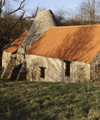July
Volunteers needed to help uncover secrets of Derwentcote

Excavation of Britain’s oldest steelworks taking place this summer
Newcastle University and English Heritage are working together to find out more about Derwentcote, the earliest and most complete steel-making furnace in Britain. Over the next four years, Dr Jane Webster of Newcastle University and Dr Rob Young of English Heritage, will investigate the row of workers’ cottages next to the steelworks. The cottages were built in the 19th century and the team will be looking for evidence about the way of life, and material world, of the people who lived there. The first season of excavations will take place until Friday, 27th July 2012 and volunteers are needed to help with the dig.Dr Jane Webster, Newcastle University said: “We’re really excited to start this series of digs over the next few years and encourage local people to get involved with the excavations. We know quite a bit about the industrial elements at Derwentcote and now we want to move on to the people who lived and worked there and find out what stories they have to tell.”
Dr Rob Young, Historic Environment Advisor, at English Heritage, said: “Derwentcote is a fascinating site in our care and both the dig and estate work are helping to train people up in much needed archaeological and heritage skills. The site is the earliest known steel works in the whole country and can tell us a lot about the North East’s industrial history and its place in the development of the steel trade.”
The project will also see English Heritage hosting a master class in conservation techniques at Derwentcote. Once the archaeological excavations are completed English Heritage will be offering training through the Heritage Skills Initiative in the use of heritage conservation techniques to consolidate the exposed cottage ruins (http://www.nect.org.uk/heritage-skills-initiative)
To become a volunteer at the dig taking place until 27th July, or to take part in future excavations, please contact jane.webster@ncl.ac.uk
Press release and photograph courtesy of English Heritage
published on: 18 July 2012
